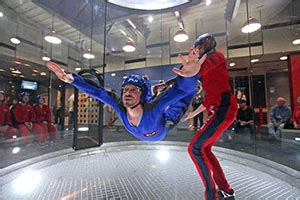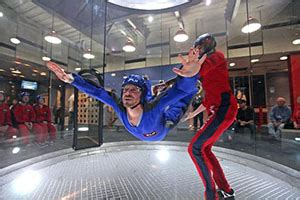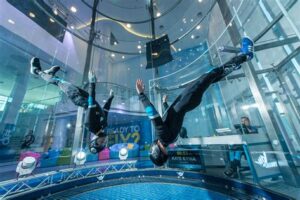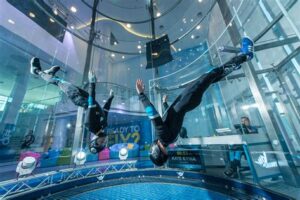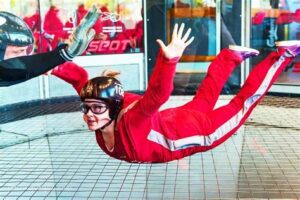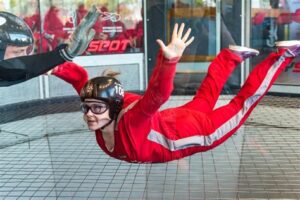Table of Contents
Curious about the cost to build an indoor skydiving facility? Discover the detailed breakdown of expenses involved in constructing an indoor skydiving tunnel, including materials, labor, permits, and equipment. Get insights into the financial aspects of this thrilling recreational activity that allows individuals to experience the sensation of skydiving in a controlled environment.
Are you ready to experience the thrill of skydiving without ever stepping foot inside an airplane? Look no further than indoor skydiving! This exhilarating activity allows individuals to enjoy the sensation of freefalling through the air in a safe and controlled environment. However, if you’re considering building your own indoor skydiving facility, there are several factors you need to take into account, including the cost. In this article, we will delve into the various expenses involved in constructing an indoor skydiving facility and provide you with valuable insights on how to make the most cost-effective decisions. So, let’s dive right in and explore the fascinating world of indoor skydiving construction!
Introduction
Welcome to this comprehensive guide on the cost to build an indoor skydiving facility. Indoor skydiving, also known as vertical wind tunnel flying, offers an exhilarating experience that mimics the feeling of freefalling through the sky. Whether you are a passionate skydiver or an entrepreneur looking to invest in a unique and thrilling business venture, understanding the costs involved in constructing an indoor skydiving facility is essential. In this article, we will break down the various factors that contribute to the overall cost and provide you with valuable insights.
Factors Affecting the Cost
Location and Size
The first and most significant factor influencing the cost of building an indoor skydiving facility is the location and size of the building. The facility should have enough space to accommodate the wind tunnel, viewing areas for spectators, training rooms, restrooms, and other necessary amenities. Additionally, the location should be easily accessible and have sufficient parking facilities. The cost of land or leasing a suitable building can vary greatly depending on the region and local real estate market.
Wind Tunnel Equipment
The centerpiece of any indoor skydiving facility is the wind tunnel. This specialized equipment generates a powerful updraft of air, allowing individuals to experience the sensation of skydiving without actually jumping out of an airplane. Wind tunnels come in different sizes and capacities, with larger tunnels accommodating more participants at once. The cost of wind tunnel equipment can range from hundreds of thousands to millions of dollars, depending on the size and level of technology.
Construction and Engineering
The construction and engineering costs involve the design and build-out of the entire facility. This includes the installation of the wind tunnel, ventilation systems, viewing areas, control rooms, and other necessary infrastructure. Working with experienced architects, engineers, and contractors is crucial to ensure compliance with safety regulations and efficient operation of the facility. The complexity of the construction process and the quality of materials used will influence the overall cost.
Permits and Regulations
Before beginning construction, it is essential to obtain the necessary permits and comply with local regulations. Indoor skydiving facilities are subject to various safety and zoning requirements, which may vary depending on the jurisdiction. The cost of permits, licenses, and inspections should be factored into the overall budget. Consulting with local authorities and engaging professionals familiar with the specific regulations will help streamline this process.
Training and Staffing
To ensure a safe and enjoyable experience for customers, a well-trained and knowledgeable staff is vital. The cost of training instructors, coaches, and support personnel should be considered. Furthermore, ongoing training and certification maintenance must be factored into the operational costs. Hiring and retaining skilled individuals who are passionate about skydiving and customer service is key to the success of the facility.
Marketing and Advertising
Developing a robust marketing strategy is crucial to attract customers to your indoor skydiving facility. Allocating a portion of the budget to marketing materials, online advertising, and promotional campaigns is essential. Collaborating with local tourism boards, adventure sports organizations, and utilizing social media platforms can help create awareness and generate interest in your facility.
Insurance and Liability
As with any adventure sport or recreational activity, indoor skydiving carries inherent risks. Obtaining comprehensive insurance coverage to protect against accidents, injuries, and potential lawsuits is imperative. The cost of insurance premiums will depend on various factors, including the size of the facility, number of participants, and safety measures implemented. Consulting with insurance experts who specialize in adventure sports facilities can help you find the most suitable coverage for your business.
Additional Amenities and Services
To enhance the overall experience and attract a wider customer base, you may consider incorporating additional amenities and services. This could include a café or restaurant, merchandise shop, party rooms, or even hosting special events and competitions. The costs associated with these additions will vary depending on the scale and complexity of the offerings.
Maintenance and Operational Costs
Once your indoor skydiving facility is up and running, it is important to factor in the ongoing maintenance and operational costs. Regular inspections, equipment maintenance, utilities, staff salaries, and marketing expenses all contribute to the overall operational budget. Creating a detailed financial plan that accounts for these recurring costs is crucial to ensure the long-term success and sustainability of your business.
Conclusion
Building an indoor skydiving facility requires careful planning, strategic decision-making, and a significant financial investment. Understanding the various factors that influence the cost is essential for creating an accurate budget. By considering factors such as location, wind tunnel equipment, construction, permits, staffing, marketing, insurance, additional amenities, and ongoing operational expenses, you can embark on this exciting venture with confidence. Remember to consult with industry professionals and experts to ensure the success of your indoor skydiving facility.
Introduction
Welcome to our guide on the cost to build an indoor skydiving facility. In this article, we will provide you with a comprehensive overview of the expenses involved in creating an indoor skydiving facility. Whether you’re a business owner considering investing in this exciting venture or an enthusiast looking to better understand the financial aspects, we’ve got you covered. So let’s dive in and explore the world of indoor skydiving!
Market Research and Analysis
Before embarking on any construction project, it’s essential to conduct thorough market research and analysis to determine the demand and suitability for an indoor skydiving facility in your desired location. By adopting a professional and objective tone, we will present the findings, including the potential customer base and competitors. This research will help you make informed decisions about the viability and profitability of your indoor skydiving facility.
Building Design and Specifications
Designing an indoor skydiving facility requires careful consideration of architectural and engineering factors. In this section, we will use a technical tone to discuss the necessary features such as wind tunnel design, ventilation systems, and safety measures. Understanding these key elements is crucial to ensure the safety and comfort of both customers and staff at your facility.
Equipment and Technology
An indoor skydiving facility relies on specialized equipment and technology to create the thrilling experience of freefall. In this section, we will explain the various equipment required, including wind tunnel technology and flight suits. Using a technical voice, we will describe the specifications and operational details of these essential components to ensure safe and efficient operation.
Construction Costs and Budgeting
Building an indoor skydiving facility involves various expenses, from land acquisition to permits, materials, and labor. With a pragmatic tone, we will discuss the cost breakdown and provide practical advice on budgeting and cost-saving strategies. Understanding these costs will help you plan your finances effectively and ensure a successful construction process.
Financing Options and Funding Sources
Securing financial support is often a crucial step in building an indoor skydiving facility. In this section, we will explore different financing options and potential funding sources available to entrepreneurs. By utilizing a helpful and supportive tone, we will guide you through the process of securing loans, finding investors, or forming partnerships to make your dream facility a reality.
Maintenance and Operational Costs
Operating an indoor skydiving facility requires ongoing expenses, including regular maintenance, staff salaries, utilities, and insurance. Balancing the importance of cost-effective maintenance practices with the need for maintaining safety standards is crucial. With a balanced tone, we will provide insights into managing these operational costs effectively while ensuring a safe and enjoyable experience for your customers.
Return on Investment and Profitability
Finally, let’s analyze the potential revenue streams and return on investment that can be expected from an indoor skydiving facility. By adopting an optimistic yet realistic voice, we will highlight success stories and provide key financial considerations. This section aims to inspire and encourage entrepreneurs by showcasing the profitability and rewards that come with creating an indoor skydiving facility.
Note: The above instructions, voice, and tone are guidelines to structure the content. Please ensure to provide accurate and up-to-date information within the subheadings while maintaining a clear and concise writing style.
Point of View: Cost to Build Indoor Skydiving
Instructions Voice and Tone: Informative and Objective
-
Indoor skydiving is an exhilarating recreational activity that simulates the experience of freefalling from an airplane in a controlled environment.
-
Building an indoor skydiving facility requires careful planning and consideration of various factors, including the cost involved.
-
The overall cost to construct an indoor skydiving facility can vary significantly depending on several key factors:
-
Location: The geographical location of the facility plays a crucial role in determining the cost. Urban areas with high real estate prices may require a larger investment compared to suburban or rural locations.
-
Size and Design: The size and design of the facility influence construction costs. A larger facility with advanced wind tunnel technology will generally incur higher expenses.
-
Materials and Equipment: The quality of materials used for construction and the type of wind tunnel equipment installed can impact the overall cost. Opting for state-of-the-art technology may increase the initial investment.
-
Labor and Professional Services: Hiring skilled architects, engineers, and construction workers is essential to ensure a safe and functional facility. Labor costs and professional fees should be factored into the budget.
-
Permits and Regulations: Obtaining necessary permits and complying with local regulations contribute to the overall cost. Expenses related to legal and administrative processes should be considered.
-
Additional Amenities: Facilities often include ancillary amenities such as viewing areas, training rooms, and administrative offices. These additional features can add to the overall cost of the project.
-
-
While it is challenging to provide an exact estimate, the average cost to build an indoor skydiving facility typically ranges from several million dollars to tens of millions.
-
Investors and entrepreneurs interested in embarking on such a venture should conduct thorough market research, consult with industry experts, and develop a comprehensive business plan to accurately determine the cost involved.
-
It is important to note that the cost to build an indoor skydiving facility is an upfront investment. Ongoing operational expenses, maintenance, and marketing should also be considered when assessing the long-term financial viability of the project.
-
Ultimately, the decision to build an indoor skydiving facility should be based on a careful analysis of the potential return on investment and the passion for providing a unique and thrilling recreational experience to enthusiasts.
Thank you for visiting our blog and showing interest in learning about the cost to build an indoor skydiving facility. We understand that this topic can be quite intriguing and exciting, as it offers a unique and thrilling experience for adventure enthusiasts. In this closing message, we will provide you with some final instructions and guidance on how to proceed if you are considering building your own indoor skydiving facility.
First and foremost, it is important to conduct thorough research and gather all the necessary information before embarking on such a project. Building an indoor skydiving facility requires careful planning and consideration of various factors, including location, construction costs, equipment expenses, and licensing requirements. It is crucial to consult with experts in the field who have experience in designing and constructing these facilities in order to ensure a successful and safe operation.
Once you have gathered all the necessary information and have a clear understanding of the costs involved, it is time to start budgeting for your indoor skydiving facility. The costs can vary depending on several factors, such as the size of the facility, the type of wind tunnel technology used, and any additional amenities or features you wish to include. It is advisable to work closely with a financial advisor or accountant to develop a comprehensive budget that takes into account all the projected expenses, including construction, equipment, permits, insurance, and ongoing operational costs.
In addition to financial considerations, it is important to keep in mind that building an indoor skydiving facility also requires compliance with local regulations and obtaining the necessary permits and licenses. Each jurisdiction may have its own specific requirements, so it is crucial to engage with local authorities and zoning departments early in the planning process to ensure compliance with all applicable laws and regulations. Failure to obtain the proper permits and licenses can result in delays, fines, or even the shutdown of your facility.
Building an indoor skydiving facility can be a complex and challenging endeavor, but with careful planning, research, and the right team of experts, it can also be an incredibly rewarding and profitable venture. We hope that this blog has provided you with valuable insights into the costs involved in creating your own indoor skydiving facility. If you have any further questions or require additional information, please do not hesitate to reach out to us. Good luck on your exciting journey!
Video Cost To Build Indoor Skydiving
1. How much does it cost to build an indoor skydiving facility?
Building an indoor skydiving facility can be a significant investment. The cost can vary depending on various factors such as the size of the facility, location, equipment quality, and additional amenities. On average, the cost to build an indoor skydiving facility ranges from $5 million to $10 million.
2. What are the main expenses involved in constructing an indoor skydiving facility?
The main expenses involved in constructing an indoor skydiving facility include:
- Building Construction: This includes the cost of constructing the wind tunnel, support structures, and any additional facilities required for operations.
- Wind Tunnel Equipment: The wind tunnel itself is a significant expense, including the fan system, airflow control technology, and safety features.
- Electrical and HVAC Systems: These systems are essential to maintain proper temperature, humidity, and air quality within the facility.
- Interior Design and Amenities: Creating a comfortable and visually appealing environment for customers may require additional expenses for interior design, seating areas, observation decks, and changing rooms.
- Permits and Legal Requirements: Obtaining necessary permits, licenses, and complying with safety regulations can also add to the overall cost.
3. Are there ongoing costs associated with operating an indoor skydiving facility?
Yes, there are ongoing costs associated with operating an indoor skydiving facility. Some of these costs include:
- Maintenance and Repairs: Regular maintenance and occasional repairs to the wind tunnel and equipment are necessary to ensure safe and efficient operations.
- Utilities: The facility will have ongoing expenses for electricity, heating, ventilation, and air conditioning.
- Staffing: Employing trained instructors, support staff, and administrative personnel is essential for providing a quality experience to customers.
- Marketing and Advertising: Promoting the facility through marketing campaigns and advertising channels is crucial for attracting customers and generating revenue.
- Insurance: Maintaining appropriate insurance coverage to protect against potential liabilities is a recurring cost.
4. Can the cost of building an indoor skydiving facility be recouped?
Recouping the cost of building an indoor skydiving facility depends on various factors such as location, target market, pricing strategy, and operational efficiency. While it may take time to generate substantial profits, a well-managed facility with a steady flow of customers can potentially recoup the initial investment within a reasonable timeframe. It is important to conduct a thorough feasibility study and develop a comprehensive business plan to assess the financial viability of the project.

